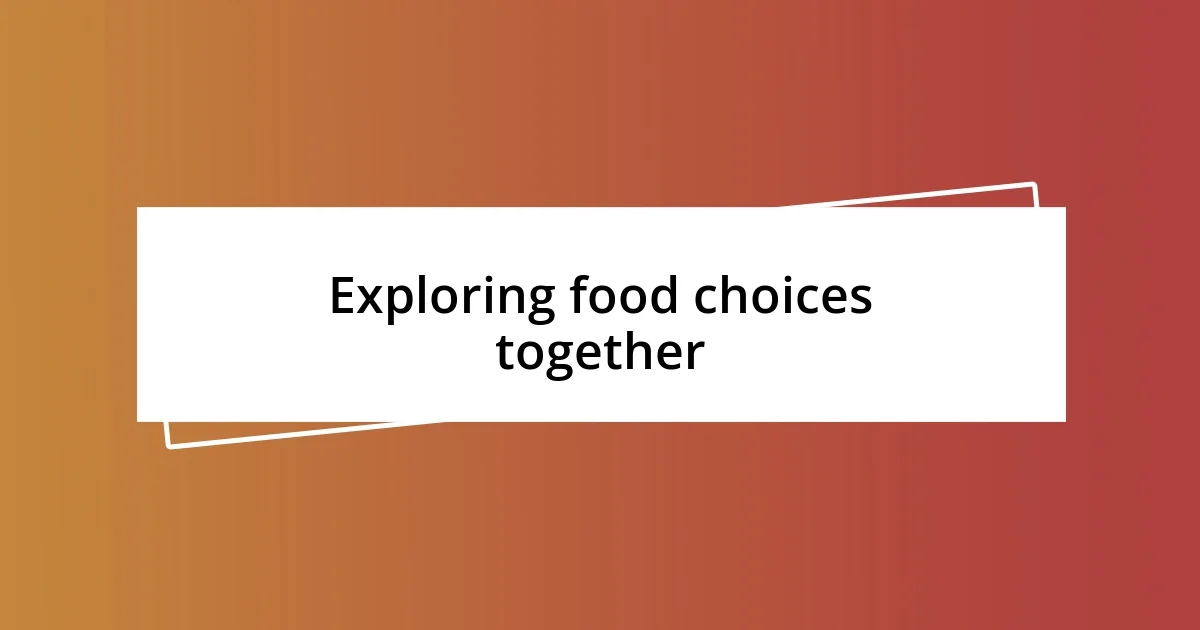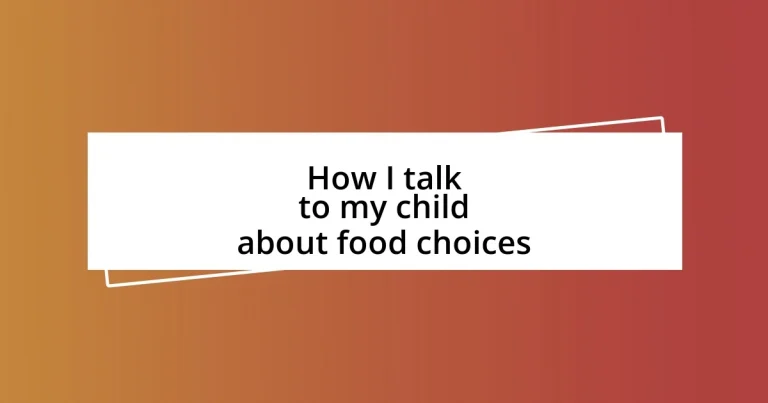Key takeaways:
- Fostering curiosity about food through hands-on activities, storytelling, and exploring diverse cuisines encourages children to develop healthy eating habits and positive relationships with food.
- Creating open conversations about food allows children to express their feelings, learn about choices, and feel validated in their preferences, ultimately enhancing their understanding of nutrition.
- Setting a positive example by modeling healthy eating behaviors and incorporating balanced treats helps children learn mindful eating and appreciate the cultural significance of food.

Understanding your child’s diet
Understanding a child’s diet can often feel overwhelming, but it’s essential to approach it with patience and curiosity. When my daughter was a toddler, I vividly remember her fascination with the vibrant colors of fruits and vegetables. It made me think: could her excitement about food be tied to how I presented it? I believe that nurturing this curiosity can foster a positive attitude towards nutrition.
It’s wise to pay attention to both the variety and balance of foods your child consumes. I once realized that my son was leaning towards a diet filled mostly with beige foods—chicken nuggets, pasta, and bread. This prompted me to ask, how do we encourage a wider range? By making the kitchen a place of experimentation, cooking colorful meals together turned into a fun bonding experience, opening the door to healthy choices without pressure.
Your child’s food preferences can also change significantly over time, influenced by factors like mood, growth spurts, or even social settings. During one family gathering, my niece refused to eat vegetables but eagerly devoured a fruit platter. This reminded me that understanding a child’s diet isn’t just about what they eat, but also about the emotions and experiences surrounding food. Isn’t it fascinating how moments shared over food can shape our relationship with it?

Teaching healthy eating habits
Teaching children healthy eating habits is not just about dictating what they should eat; it’s about fostering a curiosity and love for wholesome foods. I remember a time when my son expressed interest in a gardening project at school. Seeing his veggies thrive helped him connect with what he eats. He began to understand the journey from garden to plate, and this sparked a genuine interest in trying out new vegetables he had previously shunned.
Incorporating storytelling into our mealtime discussions has also proven effective. When I share exciting stories related to different food origins, it not only captivates their imagination but also encourages them to explore various flavors. For instance, telling my kids about how bananas are grown in tropical regions always piques their curiosity. Suddenly, trying banana pancakes became an adventure, making healthy choices feel less like a chore and more like a shared experience.
Moreover, I’ve learned that making food fun can be a game-changer. I once organized a “color hunt” where we aimed to create a rainbow salad using a variety of colorful ingredients. My kids loved the challenge and felt accomplished as they contributed to creating our meal. This playful approach not only promoted healthy eating but also instilled lifelong positive habits by embedding these choices in cherished family moments.
| Healthy Eating Practice | Personal Experience |
|---|---|
| Encouraging curiosity about food | Son’s gardening project led to trying new veggies. |
| Integrating storytelling at mealtime | Sharing food origins makes trying new foods exciting. |
| Making food preparation fun | “Color hunt” created engagement and healthy choices. |

Encouraging open conversations
Encouraging open conversations about food starts by creating a safe space where my child feels comfortable sharing thoughts and questions. I remember a moment when my daughter hesitantly asked why we didn’t have soda like her friends at school. Instead of dismissing her curiosity, I smiled and explained our choices while encouraging her to express her feelings. This openness not only deepened her understanding but also strengthened our bond, allowing her to explore her preferences without fear of judgment.
Here are a few strategies that can help promote these discussions:
-
Ask open-ended questions: Instead of yes or no questions, I often ask, “What did you think about the new recipe we tried?” This encourages her to share her genuine thoughts.
-
Share personal food stories: I find that sharing my food experiences from childhood—like how I loved homemade pizza—helps her create connections with her own food journey.
-
Validate their feelings: If she dislikes something, I let her know it’s okay and share times I’ve felt the same way—this makes her feel heard and understood.
-
Involve them in planning meals: When she’s part of the meal planning process, I notice her excitement for trying new foods increases, as it fosters a sense of ownership and investment.
By nurturing these conversations, I’ve seen how open dialogue can inspire positive food choices while making mealtime an enriching experience we both enjoy.

Exploring food choices together
Exploring food choices together has become a delightful adventure in our household. Just the other day, I took my child to the local farmer’s market, where we discovered a variety of fruits and vegetables that we’d never seen before. I encouraged her to pick out one unfamiliar item to taste at home, and we ended up with a bunch of vibrant purple carrots. The excitement in her eyes reminded me how nourishing curiosity can be, but it also made me realize that real engagement happens when we discover food options side by side.
As we prepared our meal with those purple carrots, I asked her what color she thought they might be on the inside. The moment we cut into them—revealing their bright orange flesh—was like a mini-exploration. It got me thinking; how often do we overlook the stories that food can tell? That simple act of discovery sparked not only her interest but also a deeper understanding of why we choose certain foods. It was a moment of shared joy that beautifully highlighted the importance of exploring food together.
I’ve noticed that these experiences create lasting memories that foster healthy eating habits. One week, we focused on trying foods from different countries. Each night, we’d prepare a dish and dive into the culture behind it. It was not just about eating; it became an exploration that made my child feel connected to the world. How powerful is it to know that our food choices can be gateways to understanding diverse cultures? By making food explorations a regular family activity, I’m hopeful that these lessons will stick with her for a lifetime.

Handling food-related emotions
Handling food-related emotions can be a complex journey for both children and parents. I clearly recall a time when my son expressed frustration about wanting dessert after dinner, while I felt it wasn’t the right time. Instead of brushing off his feelings, I took a moment to validate his disappointment, saying, “It’s really tough when you want something and can’t have it right away.” Acknowledging his emotions allowed us to discuss balance in food choices and helped him feel understood, making it easier to work toward a compromise.
I’ve also learned that meal times can trigger a mix of feelings, especially if a child perceives certain foods as “bad.” One evening, while eating broccoli, my daughter made a face and said, “I just don’t like it!” Instead of reacting defensively, I asked her to share what she didn’t enjoy about it. I shared how I used to dislike broccoli too, and together we brainstormed ways to prepare it that might improve her experience, like roasting with a bit of lemon. These kinds of conversations not only normalize food dislikes but also emphasize that it’s okay to have preferences and explore how to enjoy foods more.
Watching my children navigate their feelings around food has revealed a valuable lesson: emotions play an integral role in their eating experiences. When my son felt sad during a family gathering because everyone was indulging in treats he wasn’t allowed to have, we took a moment to talk it out. I recalled how I often feel the same way about my favorite dish being out of reach when on a diet. Sharing my vulnerabilities allowed him to open up, turning a moment of sadness into an opportunity for connection and understanding. Isn’t it fascinating how these emotional discussions shape a healthier relationship with food?

Setting a positive example
When I think about setting a positive example around food choices, I can’t help but recall my own childhood. I remember watching my parents as they opted for whole foods and vibrant salads over processed snacks. Their choices were more than just healthy; they painted a picture of nourishment that inspired me. It’s amazing how much our actions speak louder than our words. When I make a healthy meal or choose a colorful fruit over a dessert, I’m silently showing my children what it means to appreciate food that fuels our bodies.
I also try to cultivate an atmosphere of openness. For instance, when my kids see me enjoying a green smoothie or making an omelet with leftover veggies, they’re more likely to join in rather than shy away. I recall a weekend when we decided to cook breakfast together. I enthusiastically scrambled eggs packed with spinach and tomatoes, sharing how much energy they provide for the day ahead. Their eagerness to try it immersed us in a shared experience, reinforcing the positive impact of seeing me happily embrace nutritious choices.
Sometimes, I reflect on how I approach treats. I believe balance is key, so I intentionally include sweets in our family life but with mindful moderation. I vividly remember a rainy afternoon when we baked a batch of oatmeal cookies. I talked about how it was perfectly fine to enjoy these treats as part of a broader spectrum of food. Engaging them in this way nurtures a sense of balance and understanding, helping my children develop healthy relationships with food. How else can we prepare them for a lifetime of mindful eating if we don’t model it ourselves?

Celebrating food diversity
Celebrating food diversity opens up a world of flavors and cultures right at our dinner table. I remember the first time we tried Indian cuisine as a family; the vibrant spices filled the kitchen, and my kids were fascinated by the array of colors on their plates. I can still see their curiosity when they tasted a samosa for the first time—those smiles were priceless! Encouraging my children to appreciate different cuisines not only broadens their palates but also invites them to learn about various cultures. Isn’t it wonderful how food can be a gateway to understanding and appreciating diversity?
I often share stories of my childhood meals from around the globe, creating a narrative that sparks their interest. For instance, I reminisce about visiting my grandmother’s Italian kitchen, where the smell of fresh basil and tomatoes would envelop you in warmth and comfort. I invite my kids into the kitchen to recreate those dishes, letting them experience the joy that comes from these traditions. There’s a beautiful moment when they realize that food isn’t just nutrition; it’s a rich tapestry of history and connection. How can we cultivate a deeper bond with food if we don’t share its stories?
Incorporating food diversity into our meals has become a regular adventure. I recall a family night where we explored Mexican cuisine, making homemade tacos and choosing toppings together. It was more than just a meal; it became an event filled with laughter and teaching moments. As we mixed guacamole, my son asked why we were using avocados, and I took the chance to explain their health benefits and origins. Celebrating food diversity not only nourishes our bodies, but it also nurtures our relationships. How else can we engage our children in conversations that encourage curiosity and appreciation for the world around them?












